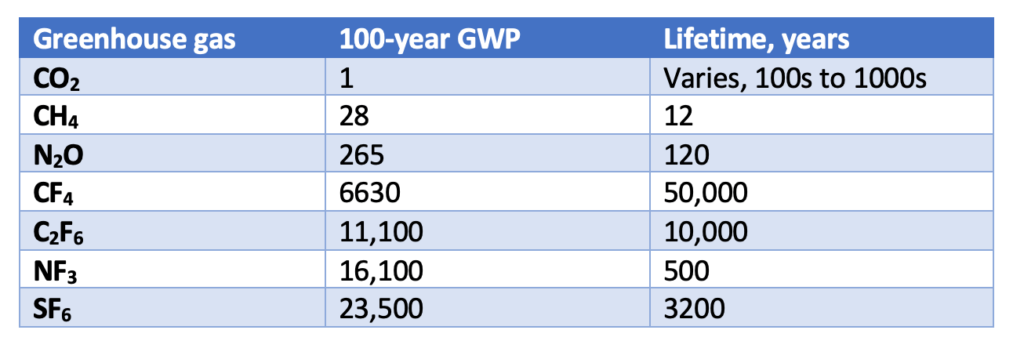The idea of semiconductor manufacturing becoming a trillion-dollar industry is astounding, exciting, or worrisome, depending on your viewpoint. Growth in the sector will provide jobs and create products that will make life better for millions of people. But the more chips we make, the higher the environmental impact of their manufacture due, in part, to the use of greenhouse gasses (GHG). Reducing GHG emissions per chip by 30% is helpful, but if you produce twice as many chips, the net result is increased emissions.
Types of Greenhouse Gasses
The first blog post in this series defined GHGs and explained the difference between Scope 1, Scope 2, and Scope 3 emissions. I won’t repeat all that info here, but feel free to go back and read for a refresher.
Briefly, GHGs include carbon dioxide (CO2), methane (CH4), hydrofluorocarbons (HFCs), and several other classes of compounds. Since each GHG contributes to global warming at a different rate, emissions are converted to a CO2 equivalent (CO2e). The global warming potential (GWP) scale is normalized to the potential of CO2, which is assigned a value of 1.
For example, methane has a GWP of around 28. That means a ton of CH4 contributes as much to global warming as 28 tons of CO2. Put another way, the CO2e of that ton of CH4 is 28 tons.
But methane isn’t prevalent in semiconductor manufacturing. Fluorinated gasses like the cleaning agent nitrogen trifluoride (NF3) and the etchant sulfur hexafluoride (SF6) are the greatest source of GHG emissions (Table 1).

GWP potential isn’t the only number that matters. Some GHGs last a long time in the atmosphere. Perfluorocarbons (CF4 and C2F6) persist for tens of thousands of years. Every ton of those compounds released into the atmosphere affects the climate for millennia. What can we do to mitigate the problem? Carbon offsets are one approach.
Carbon Offsets
There is a lot of talk about net zero emissions, with companies pledging to achieve net zero by 2030, 2040, or 2050. The idea is that they offset emissions production through activities that reduce the amount of GHGs in the atmosphere. Achieving these net zero milestones will help the environment, but less than the hype might have you believe. It matters how you get to net zero. I will illustrate that with an image.
I realize that elevation gain and loss on a bike ride is an imperfect analogy to GHG emissions and offsets. Still, bear with me and keep reading.
This is a record of a bike ride I took recently (Figure 1).

The net elevation change was nearly zero because I started and ended at the same location. Was this a flat ride? No way. I climbed 1750 feet over about 27 miles. My average speed was slower than it would have been for a flatter ride. The uphill segments slowed me down more than the downhills sped me up.
Some parts of the route included rolling hills. There, I picked up speed on the downhill portions that partially offset my effort up the next hill. That made the climb easier than if I had started from a standstill. But I still needed to expend a lot of energy to complete 1750 feet of climbing.
Companies can purchase carbon credits to offset some of their GHG emissions, but that doesn’t negate the emissions being generated in the first place. Buying offsets doesn’t magically make the emissions disappear. Nor does it erase the damage that emission-generating activities cause. No amount of tree planting or investment in renewable energy will cure diseases caused by exposure to contaminated air and water.
There is another problem with offsetting. The value of carbon credits is often exaggerated. As an article in the Guardian revealed, some projects claiming to stop deforestation do not do so. Even with legitimate projects, it is easy to make the mistake of counting efforts that would be done anyway. Investments in reforestation, carbon capture, or carbon sequestration need to be independently verified to make sure that calculations are accurate and that the projects go beyond business as usual.
A Different Approach
The dubious value of some carbon credits doesn’t mean we should abandon offsetting carbon. It does merit more effort in reducing the emissions generated. One way the semiconductor industry could do that would be to drastically cut production and commit to not building any new facilities. I know that’s unrealistic, and I don’t intend to alienate the semiconductor community with that comment. Our industry makes products that help reduce emissions in other sectors, so that benefit needs to be part of the equation.
The more realistic approach to dropping emissions is to phase out the industrial gasses with the highest GWP. Some fluorocarbons have a very low GWP. For example, the commercial etchant hexafluoro-1,3-butadiene (C4F6) has a GWP of 0.003. It is not even counted as a GHG.
Swapping out gasses is a complex process, but it is possible. Multiple companies are working on finding effective replacements without the emissions burden. Companies that buy industrial gasses can consider the trade-offs between different options in their search for a more environmentally friendly process. The faster we can replace the worst offending gasses, the better off we will be.



















